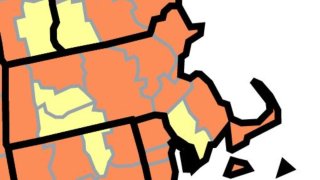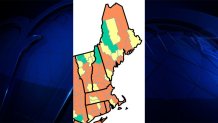
All but four of Massachusetts' 14 counties are currently considered high risk for COVID-19, according to the latest data from the Centers for Disease Control and Prevention.
The latest data released Thursday shows that Barnstable, Berkshire, Dukes, Essex, Franklin, Middlesex, Norfolk, Plymouth, Suffolk, and Worcester counties are all listed as high risk. Bristol, Hampden, Hampshire and Nantucket counties are medium risk, with no counties in the low risk category.
WATCH ANYTIME FOR FREE
Stream NBC10 Boston news for free, 24/7, wherever you are. |
The list is nearly the same as last week's, with Nantucket being downgraded from high risk this week. A week earlier, seven Massachusetts counties were listed as high risk.
Get updates on what's happening in Boston to your inbox. Sign up for our News Headlines newsletter.
Massachusetts' COVID metrics, tracked on the Department of Public Health's interactive coronavirus dashboard, declined after the omicron surge, but cases and hospitalizations have been increasing once again.
State health officials reported 4,957 new COVID-19 cases Thursday, with 866 hospitalized. The state's seven-day average positivity rate increased to 9.35% Thursday, compared to 9.13% on Wednesday.
In the last week, 18,698 students and staff members at Massachusetts schools tested positive for COVID-19. It was an increase of about 7.3% from last week — less sharp than that report's rise of 62.6%.
COVID levels in wastewater, as reported by the Massachusetts Water Resources Authority's tracking system, are also increasing.
What about the rest of New England?

In New Hampshire, only Coos County in the far north is at low risk for COVID transmission, with Cheshire County and Strafford County at medium risk. The other seven counties — including Belknap, Carroll, Grafton, Hillsborough, Merrimack, Rockingham and Sullivan — are designated as high risk.
In Vermont, Franklin County and Lamoille County are at low risk. Half of the state's 14 counties are at medium risk, including Addison, Caledonia, Chittenden, Essex, Grand Isle, Orleans and Windham counties. Five counties — Bennington, Orange, Rutland, Washington and Windsor — are at high risk.
In Maine, only Somerset County is in the lowest risk category. Kennebek County, Franklin County, Piscataquis County, Waldo County, Washington County and York County are at medium risk. The nine remaining counties — Androscoggin, Aroostook, Cumberland, Hancock, Knox, Lincoln, Oxford, Penobscot and Sagadahoc — are considered high risk.
None of Connecticut is in the lowest risk category. Fairfield County and Tolland County are medium risk, while the rest of the state, including Hartford, Litchfield, Middlesex, New Haven, New London and Windham counties, is at high risk.
All of Rhode Island was in the medium risk category for two straight weeks, but only Newport County remains there, while the rest of the state is now considered high risk.
Residents in counties with a high risk are urged to wear masks indoors in public and on public transportation, to stay up to date with vaccines and to get tested if they have symptoms, according to the CDC.
Residents in areas with medium risk are encouraged to wear a mask if they have symptoms, a positive test or exposure to someone with COVID-19. Anyone at high risk for severe illness should also consider wearing a mask indoors in public and taking additional precautions, the CDC says.
The majority of cases in New England right now are still being attributed to the "stealth" omicron variant BA.2, although cases of the BA.2.12.1 subvariant are on the rise. Increases in cases in South Africa and other countries are raising concerns that the U.S. could soon experience another COVID-19 wave.
Despite the rising cases here, Massachusetts and the other New England states have yet to take any steps to bring back mask mandates or any other COVID-related restrictions that were relaxed following January's omicron-fueled surge.



